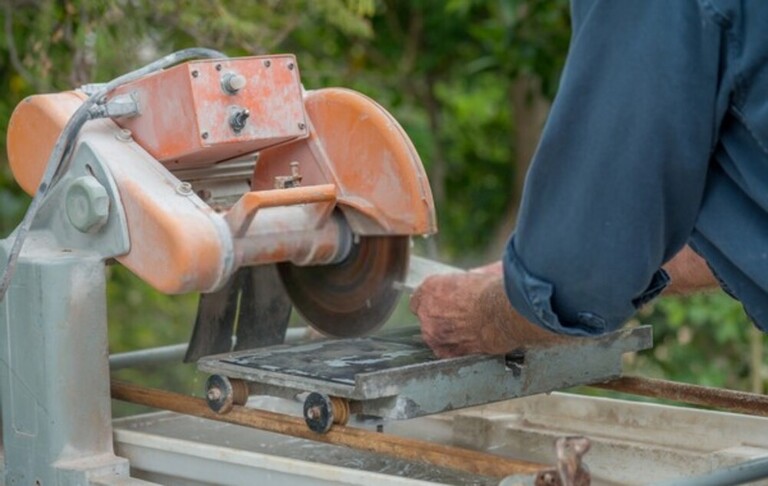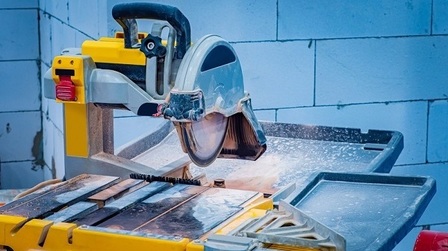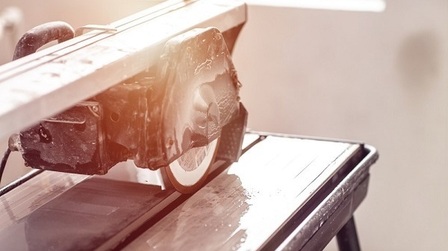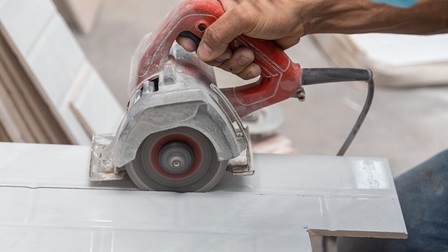The right tile saw blade needs to deliver clean cuts. But apart from the cuts, the best tile saw blade needs to be durable and affordable. There are a few types of blades you should be considered depending on the type of tile you’re planning to cut.
Abrasion Blades
Abrasion blades are the cheapest option on a tile saw blade. These blades are typically cheaper but they don’t last as long as diamond blades.
Diamond Blades
Diamond blades are more expensive. While these blades are sold at a higher price, they’re also more durable. The cuts these blades make are also smoother.
These blades might also be referred to as grinding blades. This is based on how the diamonds on the blade work. During rotation, these diamonds on the blade grind tile. But even these blades wear out eventually. It’s the high heat and the abrasion which make the diamonds fall out in time.

Types of Diamond Saw Blades
If you decide you need the best, there are a few diamond tile saw blades categories you should be familiar with
Continuous Blade

These blades have a solid or continuous edge blade. They are used on tile, porcelain, stone, and glass. You will mostly use such a continuous blade if you own a wet tile saw.
Most consider these blades as the softer options suitable for hard materials such as tile. But they also respond with the smoothest cuts. This is the main reason you would use this type of blade on any surface that remains exposed, such as marble and tile.
Serrated Blades

Serrated blades or turbo blades also have a continuous edge which is serrated. Mixed-use on various materials doesn’t recommend these blades for tile cuts.
Segmented Blades

You should not use segmented blades on the tile as they chip the material. Segmented blades are used on hard materials. Segmented blades come with cuts that create spaces in the blade called gullets. The primary role of gullets is to help dissipate air faster.
All of the above types of blades are available in different materials or bonds. A hardware store worker might ask you about the type of bond you need on your blade. Here, the bond refers to the mixture of metal that keeps the exposed diamonds in place. Soft, medium and hard bonds are available.
Wet Tile Saw Blades vs. Dry Tile Saw Blades
Wet Tile Saw Blades

These blades are normally used on a wet tile saw. They should be versatile for any tile material. A typical wet tile saw blade should not be used on a dry tile saw. It has been designed for the extra cooling aid which comes through the water.
Such a blade can be used on stone and porcelain. Since these blades are also quite versatile, they can cut through various thickness tiles, depending on your needs.
Dry Tile Saw Blades
Dry tile saw blades create a bit of a mess. But they’re normally used on handheld tile saws. However, since they require a bit more cutting skills, these tile saws might not come with the smoothest cuts, even when using the more expensive dry tile saw blades.
Tile Saw Blade Sizes
If you’re choosing a continuous edge tile saw blade, you need to know it also comes in various sizes.
Such blades can be found in sizes varying from 4 inches to 14 inches in diameter. Popular sizes include the 7-inch tile saw blade and the 10-inch tile saw blade.
Common Tile Saw Blades to Buy
There are a few common types of tile blades you can categorize by the material they’re cutting. You recognize most branded blades by their paintwork and marking. But generic-looking blades might be just as good. Here are a few examples.
Continuous Rim Tile Blades

Continuous rim tile blades are used on porcelain, marble, and even granite. Diamond Professionals make popular tile saw blades in this category. You will pay around $8.99 for a basic Bronze Wet Tile Blade of 4 ½” from Diamond Professionals.
But one of the best continuous rim tile blades is the RTC T3 Razor Gold 10-inch. The smooth blade costs more than $80 and it's known for smooth cuts and reduced cutting noise.
IQ tile saws use their own blades. IQ tile saw blades (iQTS244 10″ Q-Drive Combination Blade) are made with higher durability as they don’t use any water for cooling purposes.
But if you don’t want to test out various blades and you only have the budget for one, to begin with, a versatile qualitative choice is the Alpha Typhoon which comes in 6-inch, 8-inch, and 10-inch versions. It cost around $50.
A premium alternative with no wobble is the Alpha Porcellana which costs around $100.
Turbo Blades For Hard Tiles and Stones

Turbo blades which cut stone can be found at similar prices. Among popular options, you can find the Pearl P4. This blade was initially used on porcelain alone but its versatility was made it a bit more popular.
Disco Genius is another top blade in this category. This versatile blade costs between $53 and $149. It's known for its durability as it stays sharper on stone compared to other blades.
Alpha Q-Cut is another top performer on stone. This blade does a fantastic job on hard materials such as quartzite and granite. Alpha recommends it for 2cm porcelain paver tile cuts. This blade is newer and it replaces the much-appreciated but discontinued Alpha Numero Uno.
FAQs of Tile Saw Blade
What saw blade should I use for porcelain tile
Porcelain tile has a specific hardness to it. This is why you need to use a strong diamond blade to make the cuts. The DEWALT Diamond Blade for Porcelain Tile (DW4765) is one of the most popular blades for your first tile saw cutting job.
What is the best 7-inch blade?
It is difficult to name one blade as the best among so many options. Judging by the balance of popularity to cutting efficiency, however, the DeWalt XP4 blade can be seen as a top contender for the best in its category.
How long should a tile saw blade last?
Depending on materials and cutting technique, a tile saw blade should last for 12 hours of cutting. But you will soon find out most affordable blades only last 5-6 hours before needing a replacement. Investing in a better-quality blade at the beginning is one of the methods to ensure 12-hours cutting blade longevity.
Are porcelain tiles easy to cut?
Ceramic and porcelain tiles are considered easy to cut. In comparison, natural stone tile might require a bit more effort, especially when it comes to performing clean cuts.
How do you know when a diamond blade is dull?
There are 2 methods you can use to detect a dull blade. First, you need to inspect how the blade looks. If it’s still shiny, the blade is not dull and it can be used for a few more hours.
You can also run a finger next to the blade to feel the diamonds. You should be able to feel each diamond when the blade is in good cutting condition. When you can’t feel the diamonds with a finger, it’s a clear sign you need to replace your blade soon.
How to stop chipping while cutting?
If your cuts start to get dull, you need to use a dressing stone. This stone is used to get the diamonds sharp again. However, you can see tile chipping with a new blade. Due to the fact that most new blades have a bit of a wobble at the beginning, you may chip tile on the first few cuts before you start seeing the blade cutting tile with the expected smoothness.
How much does a tile saw blade cost?
Prices vary according to the materials and the size of the blade. You can expect to pay anywhere between $25 and $100 on your 10-inch tile saw blade. A Bosch 10-inch blade can cost around $50. A DeWalt 10-inch blade costs around $40.



